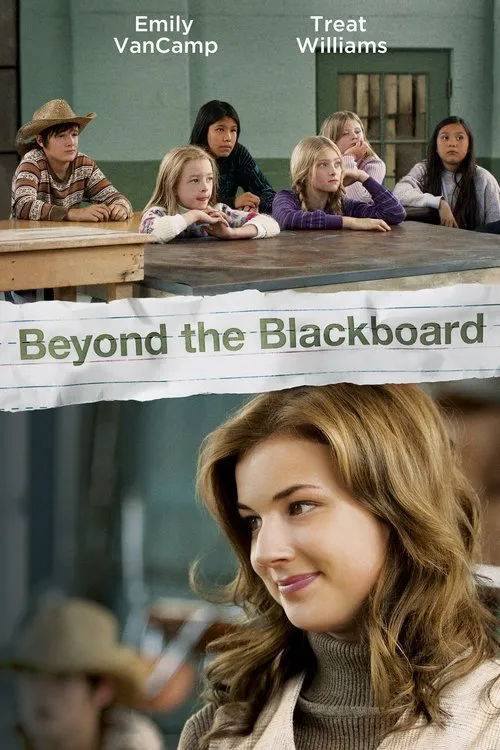Beyond the Blackboard

Plot
In the scorching heat of 1987 Albuquerque, New Mexico, a young and ambitious teacher, Stacey Bess, embarks on her first journey as a mentor in a makeshift classroom set up within a local homeless shelter. With a burning passion to make a difference in the lives of her students and a strong sense of determination, Stacey takes on a challenge that few of her peers would dare to undertake. This is the story of "Beyond the Blackboard," a heartwarming and inspiring drama that sheds light on the struggles of a dedicated teacher and the resilience of her homeless students. Stacey, a 24-year-old woman from a suburban background, has always envisioned herself in a comfortable teaching environment, surrounded by well-behaved students and state-of-the-art facilities. However, the harsh realities of the job quickly set in as she is assigned to teach in a rundown shelter with barely enough resources to go around. The classroom, referred to as "The School with No Name," is a cramped room with makeshift furniture and a limited supply of textbooks. Stacey's initial shock and disappointment slowly give way to a deeper understanding of the gravity of the situation as she witnesses the dire circumstances of her students. As Stacey struggles to connect with her students, she faces a multitude of challenges. Many of her students are young, between the ages of 4 and 12, and have never set foot in a traditional classroom before. They are the children of homeless families, forced to survive on the streets or in shelters with little hope for a better life. Stacey's students are a reflection of the harsh realities of poverty and neglect, and her own privileged upbringing makes it difficult for her to relate to their struggles. Despite the odds against her, Stacey refuses to give up. She draws strength from her own personal experiences, recalling moments from her childhood when she felt like an outsider. This connection helps her to empathize with her students, who are equally struggling to find their place in the world. Through her interactions with her students, Stacey begins to shed her own prejudices and biases, learning to see them as individuals with unique stories and talents. However, Stacey's biggest test comes from within herself. Her personal doubts and fears about her ability to teach in such a challenging environment start to surface. She questions whether she has what it takes to make a difference in the lives of her students, and whether she is truly cut out for this type of teaching. These internal struggles make her feel like a failure, and she begins to wonder if she has made a huge mistake by taking on this teaching position. Meanwhile, Stacey's students face their own set of challenges. Many of them have never had access to basic necessities like food, clothing, or healthcare. They are constantly fighting for survival, with little hope for a brighter future. Despite these daunting circumstances, they hold onto a glimmer of hope, knowing that Stacey is there to offer them a sense of stability and guidance. As Stacey navigates the complexities of her students' lives, she starts to see the world through their eyes. She realizes that each of them has a unique story to tell, despite their struggles and hardships. She discovers hidden talents and strengths in her students, from a young boy who writes beautifully to a shy girl who sings with a beautiful voice. Through these small triumphs, Stacey begins to find her own purpose as a teacher, learning to connect with her students on a deeper level. The makeshift classroom at the homeless shelter becomes a haven for Stacey and her students, a place where they can find solace and hope. Despite the lack of resources and facilities, the classroom is filled with laughter, tears, and a sense of belonging. Stacey's passion and dedication inspire her students, who begin to see themselves as capable and worthy individuals. They learn to read, write, and count, not just because they need to survive, but because they have a desire to grow and learn. In the face of overwhelming adversity, Stacey's determination and creativity become her greatest assets. She scavenges for supplies, seeking out donations and hand-me-downs to fill the gaps in her curriculum. She uses her own creativity to design lesson plans and activities that cater to the unique needs of her students. Through her selflessness and willingness to go the extra mile, Stacey makes a profound impact on the lives of her students, teaching them not just academics but also valuable life skills like resilience, empathy, and hope. As the school year draws to a close, Stacey's students reflect on their experiences in the classroom. Despite their challenges, they have grown and learned in ways they never thought possible. They have gained confidence, made friends, and developed a sense of purpose. They have learned that they are not alone, that there are people like Stacey who care about them and believe in their potential. As they say goodbye to their beloved teacher and classroom, they know that they have gained something far more valuable than just academic knowledge – they have gained a sense of dignity, self-worth, and hope for a brighter future. For Stacey, the experience has been a life-changing one. She has confronted her own biases and prejudices, learning to see the world through the eyes of her homeless students. She has discovered a newfound passion for teaching and a commitment to working with marginalized communities. As she leaves the classroom for the final time, she knows that she has made a difference in the lives of her students, and that they will always carry a piece of her heart with them.
Reviews
Recommendations




